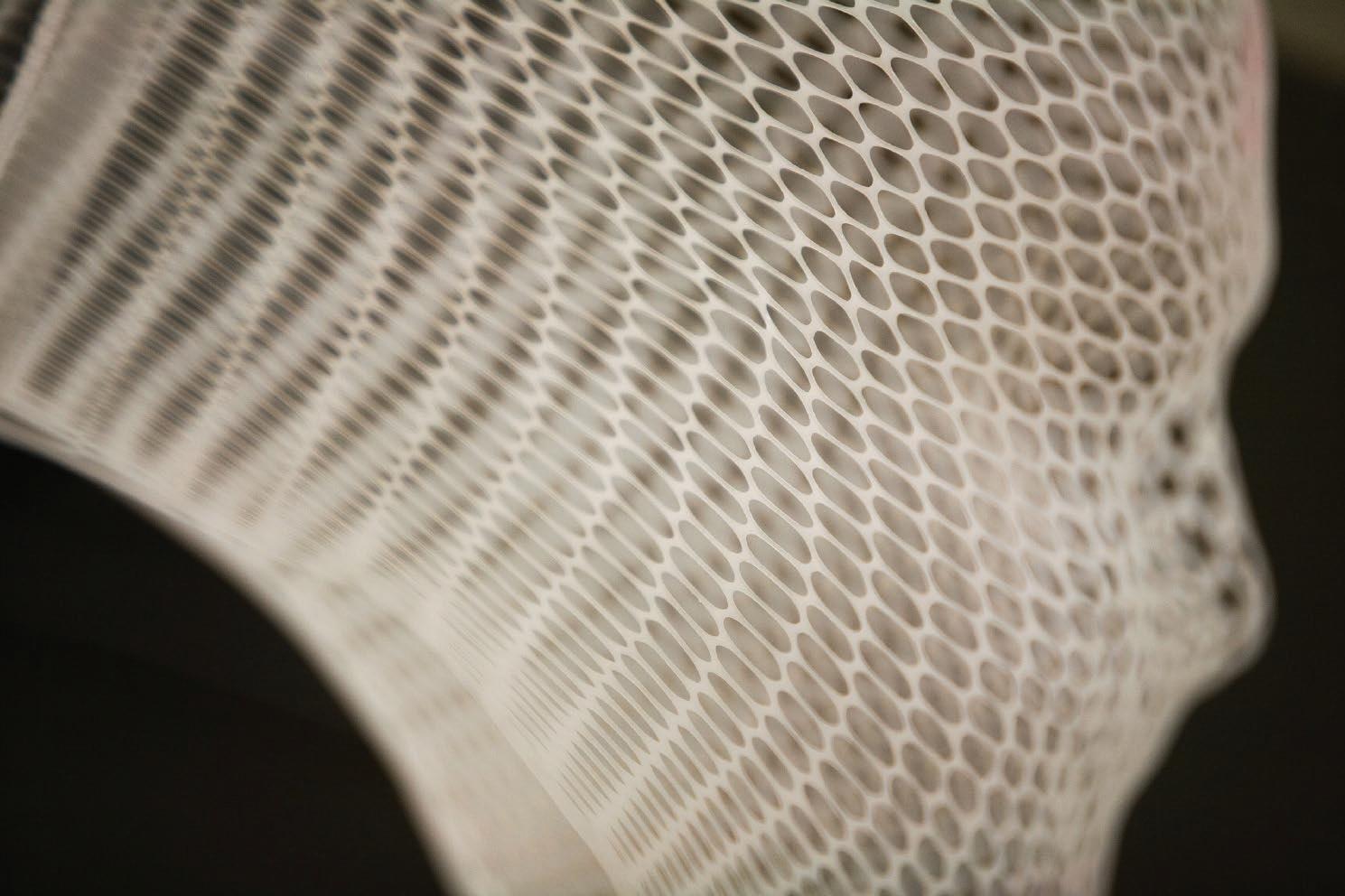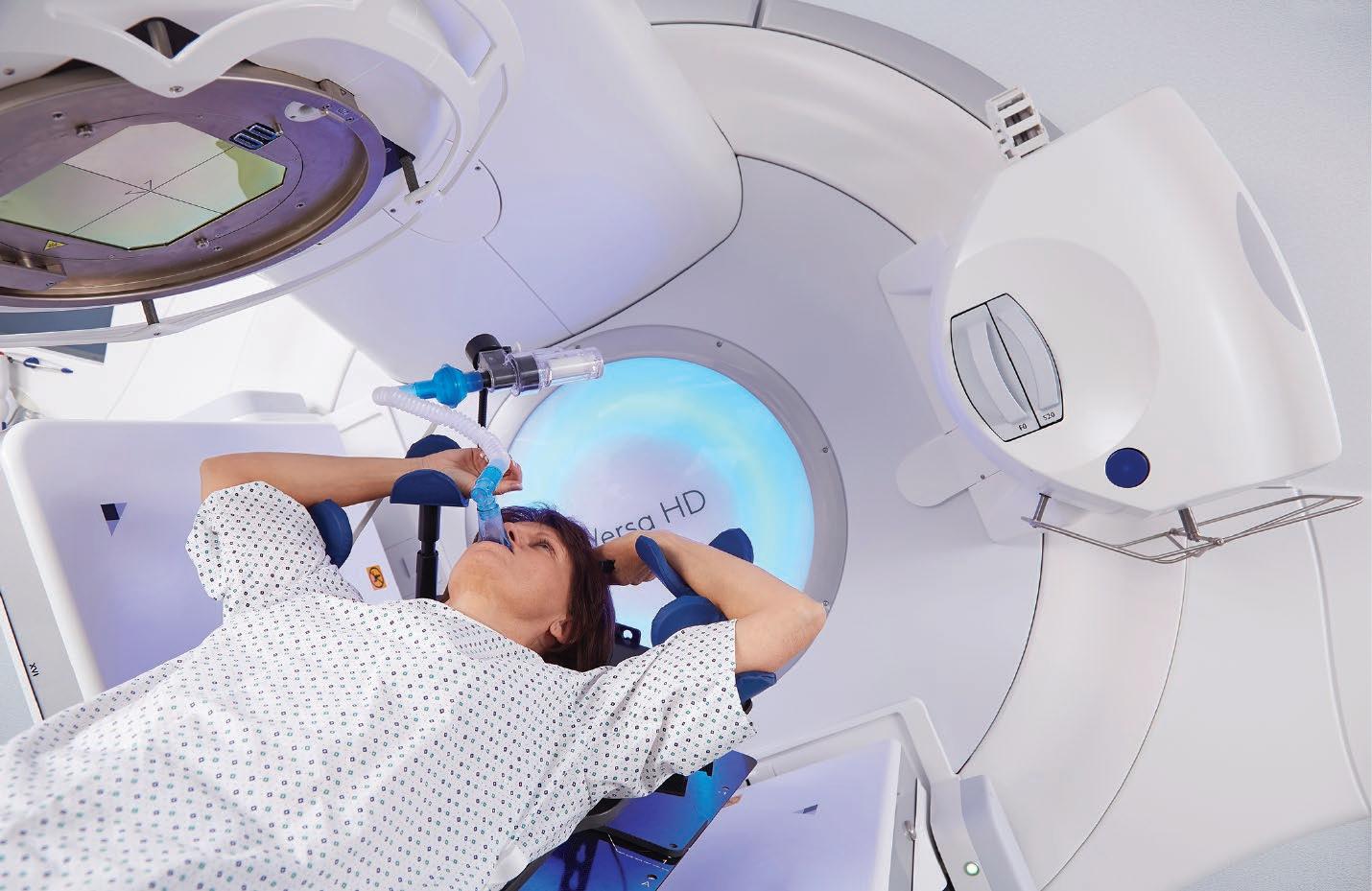
12 minute read
Stereotactic Radiosurgery a Precise, Potent Technique to Treat Brain Tumours
Elekta Ltd
Clinicians at the UK’s Nottingham University Hospital use sophisticated radiotherapy technology to lock onto and eradicate the smallest intracranial targets.
Foreword When open surgery, chemotherapy and conventional radiotherapy are poor options for a patient with a brain tumour, physicians turn to stereotactic radiosurgery (SRS). SRS is a technique that harnesses precisely focused photon beams to deliver a highly concentrated radiation dose to abnormal target tissues. Common treatment platforms include linear accelerators such as Versa HD™ (Elekta) and SRS systems such as Leksell Gamma Knife® Icon™ (Elekta). Potent SRS irradiation – often possible with a single treatment session – destroys the DNA within tumour cells, disrupting replication and triggering cell death. While SRS’s high doses spell doom for cancer cells, the technique could cause serious damage to nearby healthy tissues. This may occur as a consequence of imprecise tumour targeting and/or the dose to the lesion permeates into surrounding tissues. Fortunately, modern SRS employs advanced imaging, planning, immobilization, beamshaping, motion management, beam delivery and quality assurance methods to ensure a safe and effective treatment. Nottingham University Hospitals radiotherapy professionals have been using SRS since 2016 to help patients affected with brain tumours.
Over the last two decades, SRS has emerged as an attractive option for individuals with benign and malignant brain tumours, according to Luis Aznar-Garcia, MD, PhD, Consultant Clinical Oncologist and Brain Mets MDT (Multidisciplinary Team) and SRS Lead at the Department of Oncology, Nottingham University Hospitals (NUH), NHS Trust.
“SRS in the brain is key,” he says. “For a single brain met (metatstasis), SRS is a patientfriendly alternative to surgery and when there are multiple mets it’s the only treatment. In addition, systemic treatment of brain mets doesn’t work most of the time. SRS can achieve a local control of 80 to 90 percent, which is very similar to surgery outcomes for healthier mets patients. In the case of meningiomas and acoustic neuromas, surgery is an overly aggressive option, whereas SRS provides a minimally invasive alternative with a very good chance of local control.”
Dr. Aznar-Garcia adds that he holds a dim view of whole brain radiation therapy (WBRT),
a technique that has been associated with neurocognitive defects. “I try to avoid WBRT, except for patients with leptomeningeal disease or in cases in which there are more than 10 mets,” he says.
“At NUH and other centres worldwide, physicians are seeing increasing numbers of patients with mets, a trend due mainly to the variety and effectiveness of systemic treatments to control a patient’s extracranial primary cancer”, says Anna Bangiri, SRS Principal Radiotherapy Physicist at NUH.
“People with cancer elsewhere in the body have been living with their primary disease for a long time by virtue of the success of their chemotherapy, long enough for them to develop brain metastases,” she notes. “SRS is giving them an option for a better quality of life and, in certain cases, increased survival.”
Since August 2016, NUH has treated 350 patients, delivering SRS to five patients each week for a range of intracranial indications, including mets, meningioma and post-operative tumour cavity. The treatment of metastases is by far the most common SRS target at NUH. This trend inspired the 2018 establishment of the NUH Brain Mets Multidisciplinary Team (MDT) in the UK East Midlands, a joint effort between NUH and Macmillan Cancer Support.
“NUH is the only centre in the UK that has a Dedicated Specialist Brain Metastases MDT, which includes neurosurgeons, oncologists, palliative care specialists, physicists and radiographers. This team meets weekly to assess the needs of these patients and develop an

individualized, holistic care plan for them,” Bangiri says. “This allows us to offer unique treatments to our patients, such as a combination of surgery and SRS, in a timely manner.”
B Precision Tools for SRS The delivery of safe, effective SRS requires a variety of cutting-edge technologies, the most important of which is the linear accelerator. Before NUH considered adding an SRS service, the department had acquired a pair of Versa HD™ linacs, Elekta’s most advanced and versatile linac platform. This system is designed to give healthcare providers the flexibility to deliver conventional therapies to treat a wide range of tumours throughout the body, while also enabling treatment of highly complex cancers that require extreme targeting precision.
“We knew that Versa HD was perfectly suited for providing standard radiotherapy, but we also knew if we wanted to launch an SRS program at some point, then the system would meet all the requirements for SRS by adding some extra supporting technologies,” Dr. AznarGarcia observes.
Integral to Versa HD – and a crucial feature for SRS – is the Agility™ 160-leaf multileaf collimator (MLC) for highly conformal beam shaping. Each leaf is just 5 millimetres in width and all 160 leaves are available across the entire 40-centimeter field-of-view.
“From an SRS standpoint it’s important that the leaves can travel quite a long way across the central axis, and the six centimetre per second leaf travel speed of Agility is very helpful,” Bangiri
notes. “Because we treat multiple mets with a single isocentre, having five-millimetre leaves across the whole field-of-view ensures that all the mets in the field will have the same high conformality to the tumour shape.”
After committing to establishing an SRS service in 2016, NUH dedicated one of the Versa HD systems as a departmental SRS system. To achieve sub-millimetre accuracy for motion management and positioning correction, they acquired two pieces of supporting technology: Elekta’s HexaPOD™ evo RT robotic positioning system and Brainlab’s ExacTrac ® IGRT system for patient position tracking. HexaPOD and ExacTrac work together to ensure extreme positioning precision. These systems ensure that inter- and intra-fractional geometric uncertainties are minimized.
According to Bangiri and Dr. Aznar-Garcia, the HexaPOD-ExacTrac combination is a “must-have” for SRS and they use it for every case unless it is physically impractical.
“In SRS, patient positioning is paramount, because we’re treating very small volumes with very high doses; a geometric miss could cause damage to normal tissues,” Bangiri explains. “ExacTrac has two x-ray tubes that can very quickly image the patient from two different angles, providing information in six degrees of freedom, the x, y, and z axes and the rotational axes of roll, pitch and yaw at any couch angle. Acquiring images with the linac’s cone beam CT [CBCT] can only be done when the couch is at angle 0°. ExacTrac can also be used to image patients during beam delivery.

“HexaPOD is responsible for interpreting the information that ExacTrac provides,” she continues. “Then, with its own six degrees of positioning freedom, HexaPOD can execute patient position changes down to less than onemillimetre accuracy. “It’s important to note that this degree of accuracy eliminates the need to use a stereotactic frame on the patient’s head, which would mean using fixation pins, making our treatments minimally invasive and comfortable for patients,” Bangiri adds. “For head immobilization, we use a CIVCO head support and an AccuForm™ cushion with Orfit’s 3-point open face hybrid thermoplastic mask. This solution is custom-fit for each patient and not only ensures secure immobilization, but also provides better comfort because it’s softer than a standard plastic headrest.”
Planning for Precision “Treatment planning for small SRS targets requires a very steep dose fall-off and exceptional target conformality to spare healthy tissue”, Bangiri says. NUH uses Monaco ® , an advanced treatment planning solution from Elekta equipped with biological cost functions with multicriterial constrained optimization, a powerful leaf sequence optimizer and the gold-standard Monte Carlo dose calculation algorithm. “The Monte Carlo algorithm is very accurate and helps us produce very complex plans,” she says. “We know from our QA protocols that the plans Monaco produces are precise and from our patient follow-ups we have seen that it delivers the treatment that we intend.”
Delivering Hope for a Positive Outcome All intracranial SRS cases are delivered with Volumetric Modulated Arc Therapy (VMAT) beams and with the High Dose Rate Mode (HDRM, i.e., flattening filter-free) of Versa HD. The HDRM provides a rapid fraction and VMAT in combination with the high leaf speeds of Agility, yields exquisite conformance.
“Most of the time the treatment happens in a single fraction,” Dr. Aznar-Garcia says. “Depending on the volume of the tumour, we might deliver 22 Gy or 18 Gy if the tumour is larger than two centimetres in diameter. If the tumour is inside the brainstem, we prescribe 15 Gy in one fraction. Occasionally we have to fractionate if the tumour is larger, if the organs-at-risk dose constraints haven’t been met or if we are re-irradiating. Then, the prescription is 27 Gy spread out over three fractions. When we irradiate post-operative cavities – tumours that have been previously excised – we can offer 25 Gy in five fractions if they are very large or if the OAR constraints haven’t been met.”
Challenges Overcome A recent SRS case that exemplified the value of NUH’s MDT was one in which a patient’s surgery left a small portion of residual tumour, something of a rarity at the centre.
“We treated the cavity as we would normally do and used an integrated boost for the unresected part of the tumour,” Bangiri recalls. “I don’t think many centres can do that, but since we have the Brain Mets MDT, we were able to collaborate with the neurosurgeons on options. The cavity was large, but the residual that we could see on MRI was quite small. That is something that we had never tried to do before with Monaco, but the planning system managed to do it really well.”
A current case that the department is handling is a young patient with a BMI of 46 (356 lbs, 162 kilos) who could not have an MRI planning scan due to his size. “Because of the clear indication for stereotactic radiosurgery for this patient – his young age and a good prognosis with a single metastasis on his CT – the brain mets MDT decided to move forward with SRS,” Dr. Aznar-Garcia says. “We imaged with a CT scan using a one-millimetre slice thickness and contrast and planned with a two-millimetre margin, instead of the usual one millimetre. However, because of the patient’s size we also couldn’t use ExacTrac and had to use the linac’s CBCT. Sometimes we simply have to adapt the treatment pathway and improvise to make things work, which we were able to do in this case.”
Assuring Quality SRS Because sub-millimetre accuracy is essential for SRS, the NUH team meticulously checks its treatment tools to ensure they are performing to the required specifications.
“QA is crucial to an SRS program because we use very potent doses. High precision and accuracy are paramount, and we want to make sure the patient is getting the treatment that we intend for them to get, and that the treatment is safe for the patient,” Bangiri says. “SRS is a type of treatment where you’re ablating something, we’re aiming for the tumour to not be able to recover from that radiation exposure. If you’re not working with very high accuracy and precision, you might mistreat patients and that can potentially have dire effects for them.”
To that end, NUH’s QA protocol calls for daily checks on ExacTrac and HexaPOD and the radiographers check using the MIMI Phantom (Standard Imaging), a QA solution for HexaPOD to confirm that ExacTrac and the linac’s CBCT match and the accuracy of both systems is retained. Physicists use a ball bearing phantom on a monthly basis to recalibrate the systems and check that the coincidences – the CBCT kV, ExacTrac kV and linac isocentres – overlap to established standards.
“Until recently, we also checked every PTV for every patient’s plan prior to treatment using CIRS’s Stereotactic End-to-End Verification (STEEV), an anthropomorphic head-and-neck phantom, and EBT XD dosimetry film [GAFChromic],” she says. “We have been able to modify that QA step to check just one tumour per plan because we have gained enough confidence in our practice.”
In addition to creating, adhering to and periodically updating its own SRS practice guidelines, the NUH team also follows an exacting set of national and international practice guidelines concerning both extra- and intracranial SRS. These include the UK SABR/ SRS Consensus Guidelines for normal tissue constraints and the SABR/SRS UK Consortium Guidelines; Report 101 of the American Association of Physicists in Medicine (AAPM); International Stereotactic Radiosurgery Society (ISRS) documents and guidelines; as well as National Health Service (NHS) guidelines.
Looking Ahead As SRS technology and clinical research advance, new possibilities are emerging for patients with serious brain disease, according to Dr. Aznar-Garcia.
“We would like to not only able to offer SRS to a greater number of patients, but also to apply the technique to patients with larger numbers of metastases and with lesions smaller than 0.1 cc,” he says. “In terms of number of mets per patient, the Yamamoto trial demonstrated that SRS in patients with five to 10 brain mets is non-inferior to SRS in patients with just two to four mets.”

Another promising clinical and research frontier is the increasing use of immunotherapy with SRS, he adds. “The goal of radiation is to achieve local control but combining radiation with immunotherapy has the potential to achieve systemic control as well,” Dr. Aznar-Garcia explains. “Radiation can promote immunogenic cell death and sensitize neoplastic cells to immunotherapy. It does this by encouraging the cells’ expression of tumour antigens that prime immune cells to attack other cells in the body, including those at distant sites that haven’t received radiation. In a sense, radiation transforms the tumour into a vaccine. The synergistic action of SRS combined with immunotherapy could be a very promising treatment technique to extend overall survival.”
To make the brain mets SRS service as accessible as possible, NUH now offers patients the option of virtual clinics via video link. “All patients have to come here for treatment planning and delivery, of course, but the virtual clinics enable video follow-up appointments closer to the patient’s home,” he says. For its exceptional work in making brain mets treatment available to residents of the East Midlands, the Macmillan East Midlands Brain Metastases Service was awarded the 2019 Macmillan Innovation Excellence Award.







